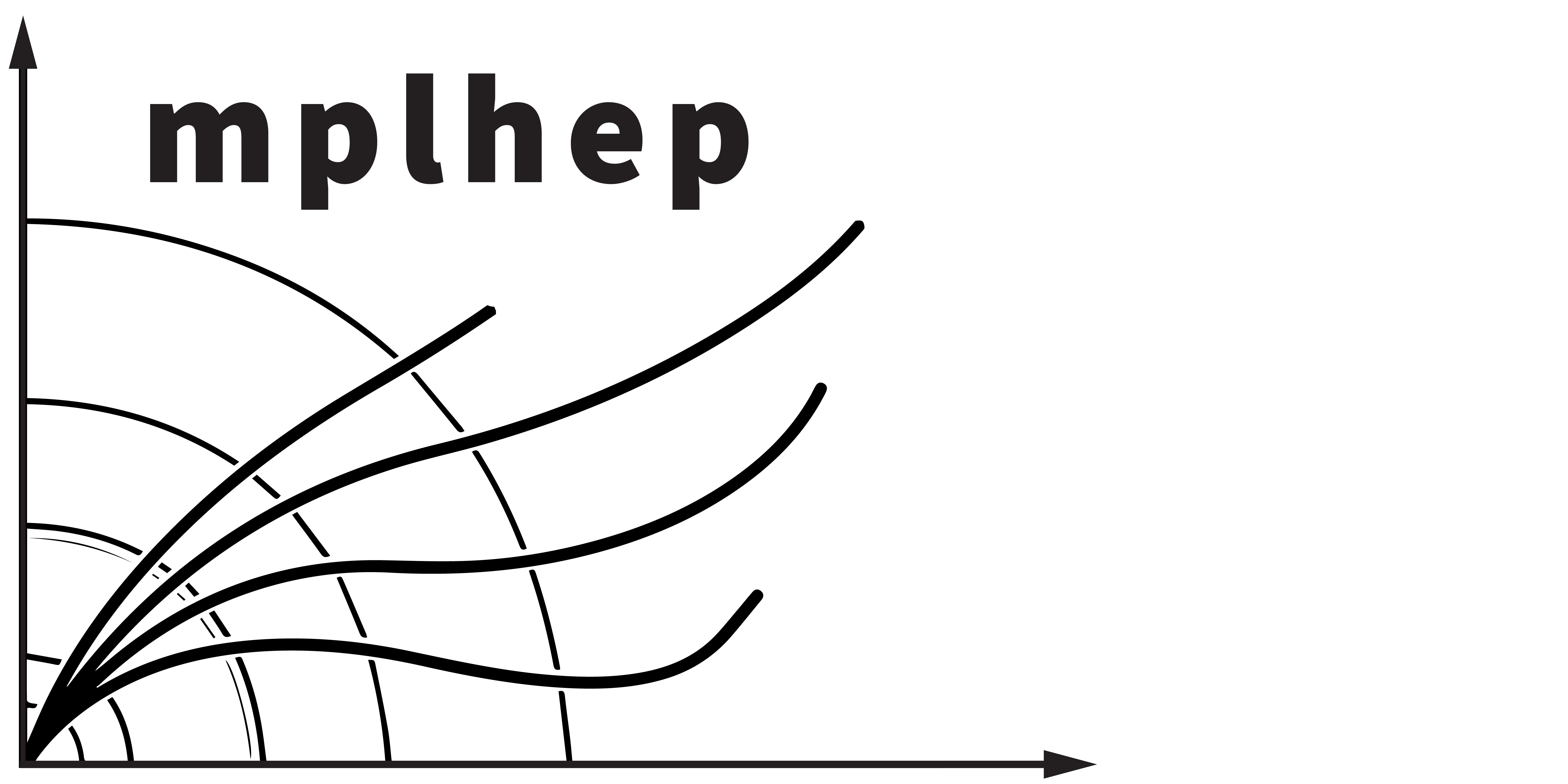
mplhep¶
Styling¶
- Easy publication grade styling
- Distribute styles and fonts
- Save real analyzer time
Plotting¶
- extend
mplwith domain specfic functions - maximally align with
mplAPI to be intuitive - upstream as much as possible
Histogram plotting¶
matplotlibnow has basic histogram plotting support -plt.stairs- some functionality remains too specific to be upstreamed - like histograms with error bars
In [ ]:
import matplotlib.pyplot as plt
import numpy as np
np.random.seed(2)
In [ ]:
H = np.histogram(np.random.normal(2.5, .5, 100), bins=np.arange(0,6, 0.5))
print("Type:", type(H))
h, bins = H
print("Values:", h)
print("Bins:", bins)
Simple Histograms¶
In [ ]:
fig, ax = plt.subplots()
ax.stairs(*H, label='Empty')
ax.stairs(h, bins + 4, fill=True, label='Filled')
ax.legend()
In [ ]:
import mplhep as hep
f, axs = plt.subplots(1,2, figsize=(14, 5))
hep.histplot(H, ax=axs[0])
hep.histplot(h, bins, yerr=True, ax=axs[1]);
Primary goal is to stay unobtrusive¶
- if you know how
plt.hist()works,mplhep.histplot()should behave like you'd expect - kwargs you are used to should work
In [ ]:
f, axs = plt.subplots(1,2, figsize=(14, 5))
hep.histplot(H, ax=axs[0], histtype='fill', hatch='///', edgecolor='white')
hep.histplot(H, ax=axs[1], histtype='errorbar', yerr=True, c='black', capsize=4)
and be able to do same things as plt.hist¶
In [ ]:
f, axs = plt.subplots(1,3, figsize=(21, 5))
hep.histplot([h, h*2], bins=bins, ax=axs[0], yerr=True)
hep.histplot([h, h*2], bins=bins, ax=axs[1], stack=True, histtype='fill')
hep.histplot([h, h*2], bins=bins, ax=axs[2], binwnorm=[20, 9]);
Be convenient for a physicist¶
In [ ]:
f, axs = plt.subplots(1,3, figsize=(21, 5))
hep.histplot([h, h*2], bins=bins, ax=axs[0], yerr=True, label=["MC1", "MC2"])
hep.histplot(np.random.poisson(h*3), bins=bins, ax=axs[1], yerr=True, label="Data")
hep.histplot([h, h*2], bins=bins, ax=axs[2], stack=True, label=["MC1", "MC2"], density=True)
hep.histplot(np.random.poisson(h*3), bins=bins, ax=axs[2], yerr=True, histtype='errorbar', label="Data", density=True, color='k')
for ax in axs:
ax.legend()
axs[0].set_title("Some MCs")
axs[1].set_title("Draw Poisson Data")
axs[2].set_title("Data/MC Shape comparison");
Be flexible about input types¶
In [ ]:
f, axs = plt.subplots(1,3, figsize=(21, 5))
my_hist = [1,2,3,4,2]
hep.histplot(my_hist, bins=range(len(my_hist)+1), ax=axs[0])
hep.histplot(H, yerr=True, ax=axs[1])
hep.histplot(h, bins, yerr=True, ax=axs[2])
axs[0].set_title("'Manual' inputs")
axs[1].set_title("Numpy Tuple")
axs[2].set_title("Unwrapped Tuple");
Process anything that implements UHI PlottableProtocol¶
In [ ]:
import uproot4
from skhep_testdata import data_path
fname = data_path("uproot-hepdata-example.root")
f = uproot4.open(fname)
print(f.keys())
print(f['hpx'])
hep.histplot(f['hpx']);
In [ ]:
import ROOT
h = ROOT.TH1F("h1", "h1", 50, -2.5, 2.5)
h.FillRandom("gaus", 10000)
hep.histplot(h);
Integrate tightly with hist¶
In [ ]:
import hist
h = hist.Hist(
hist.axis.Regular(10, 0.0, 1.0, label='X', name='x'),
)
h.fill(np.random.normal(0.5, 0.2, 1000))
hep.histplot(h);
In [ ]:
import hist
h = hist.Hist(
hist.axis.IntCategory([],
growth=True, label='Categorical Bins', name='x'),
)
h.fill(np.random.normal(5, 1, 1000))
hep.histplot(h);
2D histograms¶
- minimal wrap on
plt.pcolormesh(), which alrady has almost everything - fix(flip) indexing
- add some annotation sugar ala
sns.heatmap
In [ ]:
h2 = hist.Hist(
hist.axis.Regular(10, 0.0, 1.0, label='Some label'),
hist.axis.Regular(10, 0, 1)
)
h2.fill(np.random.normal(0.5, 0.2, 1000), np.random.normal(0.5, 0.2, 1000))
hep.hist2dplot(h2, labels=True, cbar=False);
In [ ]:
print(f['hpxpy'])
hep.hist2dplot(f['hpxpy']);
Styling¶
- Primary purpose of
mplhepis to serve and distribute styles- ALICE
- ATLAS
- CMS
- LHCb
- To ensure plots looks the same on any framework fonts need to be included
- I am liable to go on a rant, so suffice to say:
- We package an open look-alike of Helvetica called Tex Gyre Heros
In [ ]:
hep.style.use([hep.style.ATLAS])#, {'xtick.direction': 'out'}])
hep.histplot(np.histogram(np.random.normal(10, 3, 1000)));
hep.atlas.label();
In [ ]:
hep.style.use("CMS")
hep.histplot(np.histogram(np.random.normal(10, 3, 1000)))
hep.cms.label()
In [ ]:
hep.style.use()
hep.style.use([hep.style.LHCb2])
hep.histplot(np.histogram(np.random.normal(10, 3, 1000)))
hep.lhcb.label()
In [ ]:
hep.style.use()
hep.style.use([hep.style.ALICE])
hep.histplot(np.histogram(np.random.normal(10, 3, 1000)))
hep.alice.label()
Label styles¶
In [ ]:
hep.style.use()
fig, axs = plt.subplots(1, 5, figsize=(18, 3))
for i, ax in enumerate(axs):
hep.cms.label(ax=ax, loc=i)
Extended examples¶
Ratio Plot¶
In [ ]:
a = hist.Hist.new.Reg(20,-2,2).Int64().fill(np.random.uniform(-2,2,size=3000))
b = hist.Hist.new.Reg(20,-2,2).Int64().fill(np.random.normal(0,0.5,size=5000))
tot = a + b
data = tot.copy()
data[...] = np.random.poisson(tot.values())
from hist.intervals import ratio_uncertainty
In [ ]:
fig, (ax, rax) = plt.subplots(2, 1, figsize=(6,6), gridspec_kw=dict(height_ratios=[3, 1], hspace=0), sharex=True)
hep.histplot([a, b], ax=ax, stack=True, histtype='fill', label=["MC1", "MC2"])
hep.histplot(data, ax=ax, histtype='errorbar', color='k', capsize=4, yerr=True, label="Data")
errps = {'hatch':'////', 'facecolor':'none', 'lw': 0, 'color': 'k', 'alpha': 0.4}
ax.stairs(
values=tot.values() + np.sqrt(tot.values()),
baseline=tot.values() - np.sqrt(tot.values()),
edges=tot.axes[0].edges, **errps, label='Stat. unc.')
yerr = ratio_uncertainty(data.values(), tot.values(), 'poisson')
rax.stairs(1+yerr[1], edges=tot.axes[0].edges, baseline=1-yerr[0], **errps)
hep.histplot(data.values()/tot.values(), tot.axes[0].edges, yerr=np.sqrt(data.values())/tot.values(),
ax=rax, histtype='errorbar', color='k', capsize=4, label="Data")
rax.axhline(1, ls='--', color='k')
rax.set_ylim(0.7, 1.3)
ax.set_xlim(-2, 2)
ax.legend()
2D Ratio plot¶
In [ ]:
a = hist.Hist.new.Reg(5,-2,2).Reg(5,-2,2).Int64().fill(*np.random.normal(0,1,size=(2,1000)))
b = hist.Hist.new.Reg(5,-2,2).Reg(5,-2,2).Int64().fill(*np.random.uniform(-2,2,size=(2,1000)))
ratio = a.values() / b.values()
err_down, err_up = ratio_uncertainty(a.values(), b.values(), 'poisson')
def unctext(ra, u, d):
ra, u, d = f'{ra:.2f}', f'{u:.2f}', f'{d:.2f}'
return '$'+ra+'_{-'+d+'}^{+'+u+'}$'
labels = np.vectorize(unctext)(ratio, err_up, err_down)
hep.hist2dplot(ratio, labels=labels, cmap='cividis');
mplhep in publications¶
Package has already helped produce plots in several publication
We can create experiment TDR guidelines compatible plots in python
Simultaneous Jet Energy and Mass Calibrations with Neural Networks, ATLAS Collaboration, 2019
Integration and Performance of New Technologies in the CMS Simulation, Kevin Pedro, 2020 (Fig 3,4)
GeantV: Results from the prototype of concurrent vector particle transport simulation in HEP, Amadio et al, 2020 (Fig 25,26)
Search for the standard model Higgs boson decaying to charm quarks, CMS Collaboration, 2019 (Fig 1)